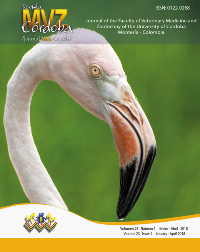Postnatal teeth procedures affect the weight gain and welfare of piglets
Los procedimientos dentales postnatales afectan la ganancia de peso y el bienestar de los lechones
Show authors biography
Objective. We carried out this study to evaluate weight gain (WG), mortality, blood serum proteins (BP), facial lesions of littermates submitted to different teeth procedures. Material and Methods. The experiment was performed in a commercial breeding farm. Were used 15 sows, allotted into three groups: control, where piglets’ teeth were kept intact (IT); teeth clipping (CT); and teeth grinding using an electric grinder (GT). We evaluated WG, BS (five males/litter), mortality, low viable piglets rates and facial lesions in piglets. Additionally, we evaluated sows’ backfat thickness (P2) and teat lesion score. BP data, lesion score and WG were assessed individually. For WG, the initial weight and the litter size were used as covariates. Regarding other variables, we used the average of the litter. When there were differences, the means were compared using Duncan test (p<0.05). Results. In the first week, GT piglets presented higher WG. In the second week, CT presented worst WG. In the first two weeks as in the total period, CT piglets presented worse WG than the GT. Mortality and low viable piglets rates were not influenced. After the fourth day, CT and GT treatment reduced facial lesions. There was no effect on BP. Treatments did not influence P2 and teat lesion score. Conclusions. Treatments did not have influence on mortality, low viable rates, BP of the piglets and P2 and teat lesions score. CT treatment decreased gain and IT increased face lesions score.
Article visits 1878 | PDF visits
Downloads
- Dzikamunhenga RS, Anthony R, Coetzee J, Gould S, Johnson A, Karriker L et al. Pain management in the neonatal piglet during routine management procedures. Part 1: a systematic review of randomized and non-randomized intervention studies. Anim Health Res Rev 2014; 15(1):14-28. https://doi.org/10.1017/S1466252314000061
- AVMA. American Veterinary Medical Association. Literature Review on the Welfare Implications of Teeth Clipping, Tail Docking and Permanent Identification of Piglets. 2014.
- Hansson M, Lundeheim N. Facial lesions in piglets with intact or grinded teeth. Acta Vet Scand 2012; 54(23):1-4. https://doi.org/10.1186/1751-0147-54-23
- Sutherland MA. Welfare implications of invasive piglet husbandry procedures, methods of alleviation and alternatives: a review. N Z Vet J 2015; 63(1):52-57. https://doi.org/10.1080/00480169.2014.961990
- Commission of the European Communities. Commission Directive 2001/93/EC of 9 November 2001 amending Directive 91/630/EEC laying down minimum standards for the protection of pigs. Official Journal of the European Communities, Brussels, p.1-3, 2001.
- Marchant-Forde JN, Lay DC, McMunn KA, Cheng HW, Pajor EA, Marchant-Forde RM. Postnatal piglet husbandry practices and well-being: The effects of alternative techniques delivered separately. J Anim Sci 2008; 87(4):1479-1492. https://doi.org/10.2527/jas.2008-1080
- Fraser D, Thompson BK. Armed sibling rivalry among suckling piglets. Behav Ecol Sociobiol 1991; 29(1): 9-15. https://doi.org/10.1007/BF00164289
- Jansen J, Kirkwood RN, Zanella AJ, Tempelman R.J. Influence of gestation housing on sow behavior and fertility. J Swine Health Prod 2007; 15(3):132-136.
- Necoechea AR. Doenças e meio ambiente. Suinocultura Industrial 1986; 8(8):13-26.
- Larsen MLV, Pedersen LJ. Does light attract piglets to the creep area? Animal 2015; 9(6):1032-1037. https://doi.org/10.1017/S1751731115000257
- Van Beirendonck S, Driessen B, Verbeke G, Permentier L,Van de Perre V, Geers R. Improving survival, growth rate, and animal welfare in piglets by avoiding teeth shortening and tail docking. J Vet Behav 2012; 7(2):88-93. https://doi.org/10.1016/j.jveb.2011.08.005
- Koller FL, Borowski SM, Asanome W, Hein G, Lagemann FL, Driemeier et al. Dental periapical abscesses in piglets affected by postweaning multisystemic wasting syndrome PMWS. Pesqui Vet Bras 2008; 28(6):271-274. https://doi.org/10.1590/S0100-736X2008000600002
- Zhou B, Yang XJ, Zhao RQ, Huang RH, Wang YH, Wang ST et al. Effects of tail docking and teeth clipping on the physiological responses, wounds, behavior, growth, and backfat depth of pigs. J Anim Sci 2013; 91(10):4908-4916. https://doi.org/10.2527/jas.2012-5996
- Stukenborg A, Traulsen I, Stamer E, Puppe B, Krieter J. The use of a lesion score as an indicator for agonistic behaviour in pigs. Archiv Tierzucht 2012; 55(2):163-170. https://doi.org/10.5194/aab-55-163-2012
























